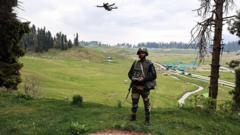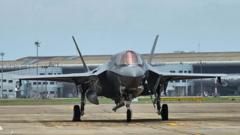As India and Pakistan engage in a new phase of conflict defined by drone warfare, experts highlight the risks and implications of aerial combat amid longstanding rivalries.**
New Era of Drone Warfare Emerges in India-Pakistan Conflict**

New Era of Drone Warfare Emerges in India-Pakistan Conflict**
Escalating tensions lead to unprecedented exchanges of drone attacks between nuclear-armed neighbors.**
The India-Pakistan conflict has entered a transformative period with the introduction of drone warfare, as accusations and counter-accusations escalate between the two nuclear-armed nations. On Thursday, India accused Pakistan of launching drone strikes against its military bases in the Jammu and Kashmir regions, while Pakistan claimed to have downed 25 Indian drones. The rising tensions have alarmed global observers, with experts highlighting the dangers of unmanned aerial conflict in a region already fraught with historical enmity.
In the last few days, violence has intensified, with reports indicating that airstrikes by India have resulted in significant casualties in Pakistan and Pakistani-administered Kashmir. These military actions are framed as responses to prior provocations, including a militant attack on Indian tourists, which India blames on Pakistan, a claim Islamabad disputes.
Both nations are now using drones not just for reconnaissance but as offensive weapons, marking a shift in their military strategies. Drones have enabled greater precision in targeting while mitigating risks to manned aircraft. Experts, such as Jahara Matisek from the US Naval War College, suggest that success in drone warfare could dictate military and political outcomes in South Asia.
India's drone capabilities, built significantly on Israeli technology, include systems capable of long-range strikes, while Pakistan’s inventory features a mix of domestic and imported models from Turkey and China. The arms race appears to be escalating, with both countries potentially seeking to enhance their drone fleets to ensure dominance in aerial combat.
While the recent exchanges signify a notable expansion in the types of engagements both nations can conduct, analysts caution against viewing them merely through the lens of military strategy. Instead, they reflect the complexity of deterrence in a region where incidents can quickly spiral out of control. Drones, while offering new tactical options, also introduce fresh challenges and a greater likelihood of miscalculation.
As the situation unfolds, the international community watches closely. The evolution toward drone warfare demands a reevaluation of how both countries approach military engagement, with the potential for significant geopolitical consequences. If these drone exchanges are merely the start of larger military operations, both India and Pakistan need to tread carefully to avoid a more extensive conflict. The world stands at a critical juncture regarding the future of the Indo-Pakistani rivalry, as both nations redefine their military doctrines in an increasingly volatile environment.



















